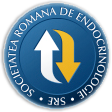
- Login
- Register
- Home/Current Issue
- About the journal
- Editorial board
- Online submission
- Instructions for authors
- Subscriptions
- Foundation Acta Endocrinologica
- Archive
- Contact
 Romanian Academy
Romanian Academy
 The Publishing House of the Romanian Academy
The Publishing House of the Romanian Academy

ACTA ENDOCRINOLOGICA (BUC)
The International Journal of Romanian Society of Endocrinology / Registered in 1938in Web of Science Master Journal List
Acta Endocrinologica(Bucharest) is live in PubMed Central
Journal Impact Factor - click here.

-
Endocrine Care
Doktur H, Tanidir C, Gunes H, Aytemiz T, Durcan G, Onal H, Kutlu E
Gender Dsyphoria and Psychiatric Disorders in Children and Adolescents with Congenital Adrenal HyperplasiaActa Endo (Buc) 2021 17(3): 365-371 doi: 10.4183/aeb.2021.365
AbstractContext. Gender identity, psychosexual function, psychiatric adjustment and quality of life have been investigated in congenital adrenal hyperplasia(CAH) patients. Objective. We aimed to investigate gender identity problems and the psychiatric disorders and associated factors in children and adolescents with CAH patients. Subjects and methods. Forty-five children and adolescents with CAH were included in the study. Psychiatric comorbidity was assessed using the Schedule for Affective Disorders and Schizophrenia for School Age Children – Present and Lifetime Version. Gender identity problems were investigated using the Diagnostic and Statistical Manual of Mental Disorders, Fifth Edition criteria. Results. The mean age of the sample was 11.02 years (SD: 3.25, range: 6–18). 51.1% of the patients had at least one lifetime comorbid psychiatric disorder. The most common diagnoses were anxiety disorders, attention deficit hyperactivity disorder(ADHD), tic disorders and enuresis nocturna. Tic disorders and ADHD were higher in males but they were not statistically significant. Two female patients were diagnosed with gender dysphoria and 18.5% of females showed variably masculinized behaviors. The girls with gender identity problems expressed lower satisfaction with their sex than other girls and boys. Conclusions. Children and adolescents with CAH had many psychiatric disorders, especially neurodevelopmental disorders. ADHD and tic disorders should be kept in mind during assessment especially in male patients. Gender dysphoria and masculine behaviors seem to be common in female patients with CAH so they should be carefully investigated. -
Case Report
Berker D, Aydin Y, Isik S, Soylemezoglu F, Tutuncu Y, Berker M, Delibasi T, Guler S
Cushing disease associated with Rathke's cleft cystActa Endo (Buc) 2010 6(3): 371-376 doi: 10.4183/aeb.2010.371
AbstractObjective: Co-existence of Cushing disease and Rathke?s Cleft Cyst (RCC) has been reported in a few cases in the literature so far. We herein describe a rare condition of Cushing disease that might originate from epithelium of RCC. \r\nCase: A 48-year-old woman was admitted to the hospital with complaints of headache, weakness, and weight gain. The patient underwent endoscopic transsphenoidal surgery due to Cushing Disease. Histopathological examination revealed cyst contents and walls compatible with RCC, and normal adenohypophysis and neurohypophysis tissues. Immunhistochemical staining with ACTH, GH, and prolactin were positive on the epithelium of the cyst. \r\nConclusion: In our case Cushing disease might be associated with hormonal activity derived from cyst wall of RCC or disappearance of a small microadenoma during surgical or pathological processing. According to recent data, origin of this lesion and histogenetic link between RCC with Cushing disease could not be explained. -
Case Report
Uslu S
Papillary Thyroid Carcinoma Following Adalimumab Treatment in Ankylosing Spondylitis: A Causal or Coincidental Association?Acta Endo (Buc) 2023 19(3): 376-379 doi: 10.4183/aeb.2023.376
AbstractThe introduction of tumor necrosis factor-alpha (TNF-α) targeting drugs has given new opportunities in the treatment of various inflammatory rheumatic diseases and has been the most important development in the treatment of ankylosing spondylitis (AS). However, the increasing use and longer follow-up periods of treatment also pose risks of developing various adverse effects, ranging from common ones, including infections, to uncommon thyroid neoplasms. Adalimumab (ADA), a fully human monoclonal antibody targeted against TNF-α, is indicated for AS. We describe the case of a patient with AS who developed a papillary thyroid carcinoma (PTC) while on therapy with ADA. Cervical lymphadenopathy and a heterogeneous nodule in the right thyroid lobe were detected in the 48-year-old female patient who had been using ADA (40 mg subcutaneously every 2 weeks) for 2 years with the diagnosis of AS. Fine-needle aspiration cytology confirmed PTC. ADA treatment was discontinued, and a total thyroidectomy surgery was performed. We believe that the thyroid gland should also be taken into consideration while screening for malignancy before and during TNF inhibitors (TNFi). -
Case Report
Tomasovic M, Sinik M, Gluvic Z, Zafirovic S, Isenovic E
Case Report of Hand and Foot Skin Changes Resembling PTU-Induced Vasculitis in a Young Male with Diffuse Toxic GoitreActa Endo (Buc) 2023 19(3): 380-385 doi: 10.4183/aeb.2023.380
AbstractContext. Propylthiouracil (PTU) could cause lupus or vasculitis-like hypersensitivities thus interfering with some other concomitant diseases. Objective. Clinicians must be aware of the side effects of medications, particularly after their introduction and long-term use. Some clinical manifestations may be similar to well-known drug side effects or hypersensitivity. Every unusual clinical scenario related to drug use must be evaluated individually and thoroughly. Subjects and Methods. Hands and feet skin changes were observed several days after PTU administration in a male patient with severe diffuse toxic goitre. A complete blood count, biochemistry analyses, thyroid function tests and antibodies, and immunology analyses were performed. Results. As the skin changes were distributed regionally, liver function tests were normal, and there were no signs of clinical deterioration, it was decided to continue PTU treatment and monitor the patient. The initial maculopapular rash quickly turned vesicular, then scaly. After two weeks, the skin changes were wholly restored, with no scarring. Hand, Foot, and Mouth disease (HFMD) was diagnosed after a thorough epidemiological survey and clinical workout. Conclusions. Our case study demonstrates that skin changes associated with HFMD may resemble those associated with PTU-induced vasculitis. -
Case Report
Vuralli D, Aytac Eyupoglu S, Kandemir N, Ozon A, Gonc N, Alikasifoglu A
Diazoxide-Induced Neutropenia and Long-Term Follow-Up in a Patient with Hyperinsulinemia-Hyperammonemia Due to GLUD1 MutationActa Endo (Buc) 2021 17(3): 383-387 doi: 10.4183/aeb.2021.383
AbstractHyperinsulinism/hyperammonemia (HI/HA) syndrome is caused by activating mutations in GLUD1 gene, and causes fasting as well as protein sensitive symptomatic hypoglycemia, in addition to persistently elevated plasma ammonia levels. First-line treatment is diazoxide, and most patients respond well to this agent, however side effects may be observed. The most frequent side effect of diazoxide is fluid retention and hypertrichosis, while hyperuricemia and hematologic side effects are observed less often. Herein, we report a case who had a heterozygous mutation of GLUD1 gene and who developed diazoxide related neutropenia 8 years after the start of treatment. On follow-up, leucopenia and mild neutropenia persisted and the treatment was changed to somatostatin analogues. However, she developed persistent severe symptomatic hypoglycemia and required diazoxide retreatment. A lower dose of diazoxide (6 mg/kg/day) successfully controlled hypoglycemia and cell counts increased even though they were not normalized. Neutropenia in current case presented after a long period of time of diazoxide use and this period is the longest defined in the literature. Long-term endocrine and hematologic follow-up of this patient up to 18 years old will also be presented. -
Case Report
Akbas ED, Ozalp Yuregir O, Anlas O, Ozcelik Z, Tolunay O
A Novel Variant in Triple a SyndromeActa Endo (Buc) 2021 17(3): 384-386 doi: 10.4183/aeb.2021.384
AbstractTriple A syndrome is an autosomal recessive inherited multisystem disorder that was first described in 1978. Triple A syndrome has a high genotypic and phenotypic heterogeneity and has been linked with mutations in the AAAS gene, which has been identified on chromosome 12q13. A 14 years old male patient applied to outpatient clinic complaining of weakness and darkening of skin color since 4 months. On physical examination hyperpigmentation was observed on both the skin and mucosa. The morning cortisol level was 1.8 μg/dL and ACTH was >1250 ng/L. Schirmer test showed absence of tears. In the patient’s esophagoscopy, mucosal paleness and stenosis of the cardia were observed. Molecular genetic analysis of AAAS gene confirmed the diagnosis of triple A syndrome caused by homozygous mutation: c.1368_1372delGCTCA (p.Gln456HisfsTer38). This variant is considered to be a possible pathogenic because it causes a frame shift that changes the protein structure. As a result of the genetic analysis of the patient’s parents, the AAAS gene was detected as heterozygous in both parents for the c.1368_1372delGCTCA mutation. To the best of our knowledge, this is the first report of homozygous mutation: c.1368_1372delGCTCA (p.Gln456HisfsTer38). -
Case Report
Karakilic-Ozturan E, Ozturk AP, Oney K, Kardelen Al AD, Yildirim ZY, Balci HI., Poyrazoglu S, Bas F, Darendeliler F
SLC34A3 Gene Mutation as a Rare Cause of Hypophosphatemia in Two SiblingsActa Endo (Buc) 2022 18(3): 387-391 doi: 10.4183/aeb.2022.387
AbstractContext. Hereditary hypophosphatemic rickets with hypercalciuria (HHRH) is a rare autosomal recessive disorder, which is characterized by renal phosphate wasting, hypercalciuria, increased 1,25-dihydroxyvitamin D, and decreased parathormone (PTH) levels. Objective. Here we report different clinical features of two siblings with HHRH, confirmed with molecular diagnosis. Subjects and methods. 16.4 years old boy (P1), and 8.7 years old girl (P2) were referred to our outpatient clinic due to clinical suspicion of metabolic bone diseases. Results. P1 had severe hypophosphatemia. Additionally, PTH concentration was near to the lower limit, 1,25-dihydroxyvitamin-D concentration was near to the upper limit. P2 had relatively milder clinical and laboratory findings. Bilateral renal calculi were detected on ultrasound in both of them. HHRH was suspected due to their described biochemistry and the presence of bilateral renal calculi. Molecular analysis of SLC34A3 gene revealed a homozygous variant c.756G>A (p.Gln252=) and a splice donor variant c.1335+2T>A. After oral phosphate treatment, clinical and biochemical improvements were observed. However treatment nonadherence of patients was a barrier to reach treatment goal Conclusion. The clinical phenotype due to the same mutation in the SLC34A3 gene may vary even among the members of the same family. An accurate diagnosis is important for the appropriate treatment. -
Case Report
Dima SO, Dumitrascu T, Pechianu C, Grigorie RT, Brasoveanu V, Sorop A, Lupescu I, Purnichescu-Purtan R, Croitoru A, Bacalbasa N, Tanase A, Tomescu DR, Herlea V , Popescu I
Prognostic Factors in Patients with Surgical Resection of Pancreatic Neuroendocrine TumoursActa Endo (Buc) 2018 14(3): 389-393 doi: 10.4183/aeb.2018.389
AbstractContext. Pancreatic neuroendocrine tumours (PanNETs) are rare pancreatic neoplasms. PanNETs can be treated by multimodal approach including surgery, locoregional and systemic therapy. Objective. The aim of the present study is to evaluate predictive factors of overall survival in patients with PanNETs surgically treated at a single center. Subjects and methods. The study group consisted of 120 patients with PanNETs who had undergone surgery at the Center of Digestive Diseases and Liver Transplantation of Fundeni Clinical Institute, Bucharest, Romania. Surgical resection of the primary tumor was performed in 110 patients. Results. Tumor size > 2 cm (p=0.048) (90% CI) lymph node involvement (p=0.048), ENET grade (p<0.001), distant metastases (p<0.001), Ki 67 index (<2%, 2-5%, 5-10%, 10-20%, >20%) (p<0.001) were identified as significant prognostic factors for OS on univariate analysis. Using multivariate Cox proportional regression model we found that distant metastases and Ki 67 index were independent risk factors for the survival outcome. Conclusions. Surgery with curative intent should be considered in all cases if clinically appropriate and technically feasible. High grade (Ki67 index ≥10%) tumours were associated with a 2- fold increase in risk of death as compared to those with a Ki67 <10% -
Case Report
Croitoru A, Dinu I, Herlea V, Becheanu G, Grasu M, Lupescu I, Dima SO, Buica F, Dumitrascu T, Lungulescu C, Croitoru VM, Tanase A, Negru SM, Gramaticu IM
Large Cell Metastatic Pancreatic Neuroendocrine Carcinoma Treated with Somatostatin Analogues - Case Report and Literature ReviewActa Endo (Buc) 2019 15(3): 390-397 doi: 10.4183/aeb.2019.390
AbstractWe report the case of a 55-year-old-male with a large cell metastatic pancreatic neuroendocrine carcinoma treated for 14 months with lanreotide autogel having a stable disease (SD) and not responding to chemotherapy. The somatostatin analogues (SSA) were introduced after an episode of diarrhea and controlled the disease. Progression-free survival (PFS) as determined by Computerized Tomography (CT) scans was obtained for 14 months. After more than a year, the patient’s health state deteriorated along with progressive disease. The capecitabine-temozolomide regimen was challenged, but after three cycles, a rapid clinical decline was noted. Conclusion. This unexpected event (diarrhea) in the course of the disease could represent the beginning of carcinoid syndrome. While the lanreotide autogel helped the episode of diarrhea pass, it also helped gain control over the disease itself. -
Case Report
Vlad M, Cornianu M, Lazar F, Golu I, Zosin I
Graves disease and follicular thyroid carcinoma. Case reportActa Endo (Buc) 2009 5(3): 399-405 doi: 10.4183/aeb.2009.399
AbstractThe detection of thyroid nodules in a patient with Graves’ disease is not a rare event.\r\nThe management of these cases still represents a controversial problem for clinical practice.\r\nThis paper describes the case of a patient with Graves’ disease and a concurrent\r\nfollicular thyroid carcinoma, presenting as a clinical palpable nodule in the right lobe.\r\nThyroid function tests confirmed thyrotoxicosis. Immunological investigations showed high\r\nlevels of TSH-R antibodies. Thyroid ultrasound revealed an increased thyroid volume with\r\na diffuse low echogenicity of parenchyma and in the right lobe a single homogeneous\r\nhypoechoic nodule. The scintiscan indicated the presence of a “cold nodule” in the right lobe\r\nand increased uptake in the rest of parenchyma. Antithyroid drug therapy was\r\nrecommended. Cytological exam indicated an “indeterminate” smear. After euthyroidism\r\nwas achieved, surgical therapy was recommended and near total thyroidectomy was\r\nperformed. The morphopathological exam revealed an invasive follicular carcinoma on a\r\ndiffuse thyroid hyperplasia (Graves’ disease). This case report is followed by a discussion\r\nabout the incidence of malignancy in thyroid nodules concurrent with Graves’ disease. The\r\ncriteria that raised concern about a possible malignancy of the nodule are presented.\r\nIn conclusion, we recommend that patients with Graves’ disease should undergo a\r\nregular examination of the thyroid gland for an early detection of possible malignant\r\nnodules. The intervention of choice in these cases should be near total or total\r\nthyroidectomy, if malignancy cannot be excluded by preoperative evaluation.